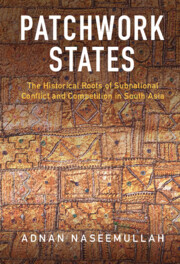Book contents
- Patchwork States
- Patchwork States
- Copyright page
- Contents
- Figures
- Tables
- Preface
- Abbreviations
- Part I Framework
- Part II Historical Roots
- 3 The Making of Patchwork Authority
- 4 The Patchwork Nature of Colonial Governance
- 5 Postcolonial Patchwork States
- Part III Contemporary Consequences
- Part IV Conclusions
- Book part
- References
- Index
5 - Postcolonial Patchwork States
from Part II - Historical Roots
Published online by Cambridge University Press: 09 June 2022
- Patchwork States
- Patchwork States
- Copyright page
- Contents
- Figures
- Tables
- Preface
- Abbreviations
- Part I Framework
- Part II Historical Roots
- 3 The Making of Patchwork Authority
- 4 The Patchwork Nature of Colonial Governance
- 5 Postcolonial Patchwork States
- Part III Contemporary Consequences
- Part IV Conclusions
- Book part
- References
- Index
Summary
This chapter explores the ways that postcolonial governments of India and Pakistan attempted to homogenize governance arrangements within their territories; this project was not entirely successful, but did lead to substantial revision of colonial categories. It begins with a discussion of the foreclosed possibility of Home Rule arrangements in which distinctions in governance practice might have persisted in practice after independence in a united India; the politics of Partition instead led to the formation of two sovereign states, but with significant variation in the power and authority of the state in each. It explores the particular politics in India and Pakistan that limited each country’s ability to undertake fundamental reform of the state and the homogenization of governance procedures, including differing perspectives among political leaders on how best to deliver security and development, and the persistence of bureaucratic structures. It also outlines the roots of a more even political geography in Bangladesh, an exception to the patchwork states of India and Pakistan. The chapter concludes with a discussion of how the colonial forms of governance translates into a postcolonial typology of governance arrangements, with distinctions in state capacity and state-society relations.
- Type
- Chapter
- Information
- Patchwork StatesThe Historical Roots of Subnational Conflict and Competition in South Asia, pp. 104 - 130Publisher: Cambridge University PressPrint publication year: 2022

